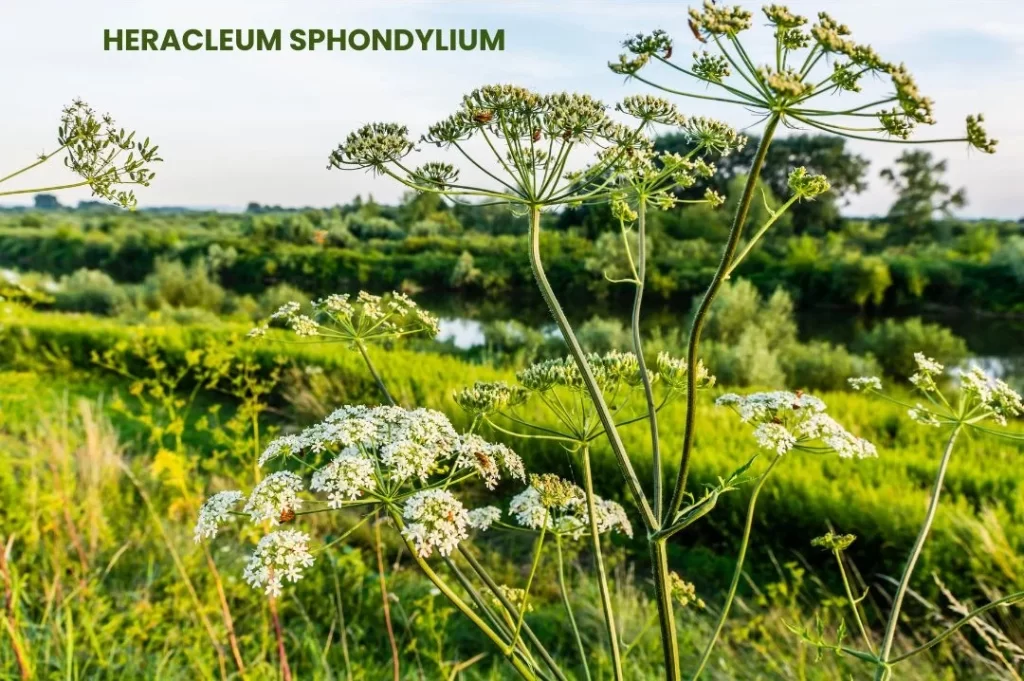Heracleum Sphondylium, commonly known as Cow Parsnip, is a large perennial herb belonging to the Apiaceae family.
It is widely used in homeopathy to address skin conditions, digestive issues, and inflammatory disorders.

Table of Contents
ToggleSOURCE INFORMATION
Scientific Classification
- Kingdom: Plantae
- Clade: Angiosperms
- Order: Apiales
- Family: Apiaceae
- Genus: Heracleum
- Species: H. sphondylium
Common Names
- Cow Parsnip
- Hogweed
Description
Cow Parsnip is a robust, perennial herb that can grow up to 1.8 meters (6 feet) tall.
It has large, broad leaves and umbrella-like clusters of white flowers.
The plant produces a distinct smell and contains furanocoumarins, which can cause skin irritation in sensitive individuals when exposed to sunlight.
Habitat and Distribution
Heracleum Sphondylium thrives in moist, nutrient-rich soils and is commonly found in meadows, along roadsides, and in forest clearings across Europe and Asia.
It prefers temperate climates and can often be seen in wild or semi-wild environments.
Traditional and Medicinal Uses
Historically, Heracleum Sphondylium has been used in traditional medicine for various ailments. Some of its applications include:
- Anti-inflammatory: Used to reduce inflammation and swelling.
- Digestive Aid: Helps in relieving digestive issues such as bloating and indigestion.
- Skin Conditions: Applied topically to treat conditions like eczema and dermatitis.
- Respiratory Issues: Used in traditional remedies for coughs and bronchitis.
Homeopathic Use
In homeopathy, Heracleum Sphondylium is utilized for treating a range of symptoms, particularly those affecting the skin and respiratory system.
It is also employed in addressing digestive disturbances and inflammatory conditions.
DRUG PATHOGENESIS
Heracleum Sphondylium primarily affects the skin and digestive tract.
It is known to cause skin irritation upon contact and is used in homeopathy to treat conditions that mimic these symptoms, such as dermatitis and gastrointestinal disturbances.
KEY CHARACTERISTICS
SKIN
- Red, Itchy Eruptions: The skin shows red patches that are intensely itchy, which can lead to scratching and further irritation.
- Blistering and Burning Sensations: Blisters form on the skin, accompanied by a burning feeling, causing significant discomfort.
- Eczema and Dermatitis: Conditions like eczema and dermatitis are prominent, leading to inflamed, itchy, and red skin.
- Skin Hypersensitivity to Sunlight (Phytophotodermatitis): Exposure to sunlight causes an allergic skin reaction, resulting in severe redness, blistering, and dark patches.
DIGESTIVE SYSTEM
- Abdominal Pain and Cramps: There is significant pain and cramping in the abdomen, indicating digestive disturbances.
- Diarrhea and Dysentery: Frequent, loose stools and potentially blood-streaked stools characterize these conditions, often with an urgent need to defecate.
- Flatulence and Bloating: Excessive gas buildup leads to a feeling of fullness and discomfort in the abdomen.
GENERAL
- Sensation of Swelling and Heaviness in the Limbs: The limbs feel swollen and heavy, making movement uncomfortable.
- Inflammatory Conditions, Especially Aggravated by Heat and Sunlight: Inflammatory responses in the body are heightened, particularly worsening in warm environments or after sun exposure.
- Swelling and Pain in Joints: Joints become swollen and painful, indicating inflammation and potential arthritis.
MODALITIES
- Better: In cool environments and with rest
- Worse: In warm conditions, exposure to sunlight, and with physical exertion
WHAT ARE MODALITIES IN HOMOEOPATHY?
RELATIONSHIP WITH OTHER DRUGS
Compare with
- Apis mellifica: Known for treating skin conditions with burning and swelling.
- Rhus toxicodendron: Used for skin eruptions and joint pain.
- Arnica montana: Beneficial for inflammation and bruising.
DOSE
- Potency: Typically administered in low to medium potencies (e.g., 6C to 30C), depending on the severity and type of symptoms.
Frequently Asked Questions (FAQs)
What conditions is Heracleum Sphondylium used for in homeopathy?
- Heracleum Sphondylium is primarily used for skin conditions such as dermatitis, eczema, and burns, as well as digestive issues like abdominal pain, diarrhea, and flatulence.
How does Heracleum Sphondylium affect the skin?
- It can cause red, itchy eruptions, blistering, and burning sensations, particularly when the skin is exposed to sunlight.
- It is used to treat similar skin conditions in homeopathy.
What are the digestive symptoms treated by Heracleum Sphondylium?
- It is used to address abdominal pain, cramps, diarrhea, dysentery, and bloating.
What are the key modalities of Heracleum Sphondylium?
- Symptoms improve in cool environments and with rest, and worsen in warm conditions, exposure to sunlight, and with physical exertion.
How is Heracleum Sphondylium typically administered in homeopathy?
- It is usually administered in low to medium potencies, such as 6C to 30C, tailored to the individual’s symptoms and overall health condition.
Glossary of Difficult Words
- Phytophotodermatitis: A skin reaction that occurs when certain plant chemicals come into contact with the skin and are then exposed to sunlight, causing a rash or blisters.
- Dermatitis: Inflammation of the skin.
- Eczema: A condition that causes the skin to become red, itchy, and inflamed.
- Diuretic: A substance that promotes the increased production of urine.
- Dysentery: Infection of the intestines resulting in severe diarrhea with blood.
